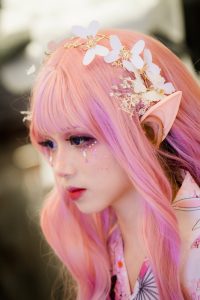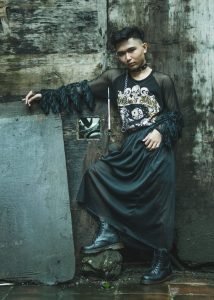It’s important that people discover their identity and understand who they are. For teenagers, adolescent identity development is especially important. This is because adolescence is a key time for identity development. Because of this, you may see teens experimenting with their fashion style and music. Since I work with a lot of teens, I know how music and popular culture can help teens develop their sense of identity. With this awareness, I support teens in being able to feel comfortable and confident in who they are. This can help them with their identity development.

I think we all can agree that adolescence is harder now than ever before. With the internet and social media, there is so much content out there that can demand a teen’s attention. Sometimes this content can overload teens, or be distracting. In that sense, these things can be a problem. But popular culture can also help teens figure out who they are. What music/movies/TV shows/video games/book/characters do they resonate with? In this blog, I’ll share some ways that music and popular culture can help teens develop a sense of identity.
Adolescent Identity Development
First, a brief explanation about why identity development is important during adolescence. Simply put, identity development is a vital component of human development. It contributes to who we are as a person and who we’ll be as an adult.
Influential to my work is Erik Erikson’s theory of psychosocial development. It outlines the different stages of life and the developmental tasks of each stage. Each stage involves a crisis or conflict that the person needs to overcome to move onto the next stage. Experiences had at each stage and how a person works through each stage have an impact on later stages.

Made up of 8 stages, the fifth stage of development in this model corresponds to adolescence. The stage is called identity vs. role confusion. According to Erikson, this stage affects adolescents ages 12-18. The developmental task of this stage centers around developing a personal identity. If teens can do this, they can gain a strong sense of self that stays with them throughout their lives. [1]
During this stage, teens develop a greater sense of self. This includes who they are outside of their family. Independence, acceptance, and understanding are important to teens at this stage. While parents and family still play an influential role in teens’ lives, it’s different now. A teen’s identity and sense of self isn’t solely dictated by family during adolescence. Outside forces also become particularly important during this time. Friends, peers, societal trends, and even popular culture all help to shape identity. Popular culture in particular influences adolescent identity development.
Adolescent Identity Development and Appearance
Being the parent of a teenager is hard. Your child is going through a huge stage of growth and development that often excludes you. They may be trying out different ways to express themselves that may not make sense to you. Perhaps they’re changing their appearance. Or maybe they’re trying out new interests or tastes in music. It’s important to remember that self-expression is important for teens at this time as they figure out who they are. This is because it helps them to figure out who they are.

This can include trying on new identities and experimenting with different appearances. It can also include new interests. Some of these choices and changes can startle parents but they’re normal. [2] Try thinking back to your own adolescence. Did your parents or other adults comment about how you expressed yourself as a teen? If so, how did that impact you? Try to keep that in mind when you find yourself judging your teen’s appearance.
In general, teens are looking for their identity beyond their family and school. They’re turning to friends, clubs, and hobbies. Older teens may have jobs. Perhaps they’re thinking about what happens after high school. Younger teens are starting to think about what high school will be like for them. Teens at this developmental stage are finding their place in society. And you have to admit that the society they’re needing to find their place in likely looks different from the one you or I grew up in.
Popular Culture and Music Help Teens Develop Their Identity
Popular culture and music are two ways that teens express themselves. This is why music therapy can be so helpful for adolescents figuring out their identity. They identify with different genres of music as well as certain songs, artists, and lyrics. These musical genres often come with an aesthetic style.
Two genres that many of the teens I see for music therapy sessions identify with are emo and mumble rap. I’ll look at those specific genres in greater detail below.
The Influence of Popular Subcultures on Style and Adolescent Identity Development
But first, I want to talk about the role of style in adolescent identity development. The first thing you notice about a person when you first meet them is their appearance, right? Style is a key area for exploration in adolescent identity development.
E-Girls and E-Boys
A style and aesthetic that I see in many of the teens I work with falls under that of E-girls and E-boys. E-girls and E-boys are a youth subculture tied to social media. Teens explore their identity through E-girl and E-boy posts on TikTok. E-boys and E-girls are an exploration of gender, gender roles, and expectations. [3]
The style of an E-girl is one that consists of brightly colored hair and winged eyeliner. As a style, it has some anime influence. E-boys often also have colored hair but usually wear beanies and belt chains. [5]
E-girls and E-boys create digital personas. Most of the time E-girls and E-boys are posting alone from their bedrooms. [5] They create an online persona different than real life. They’re trying to figure out who they are in the world as they understand it under heavy pop culture influences.
Cosplay

Another style and aesthetic that I see in many of the teens I work with is cosplay. Cosplay is a different kind of identity exploration. You can consider it to be performance art. People dress as their favorite characters from anime, video games, television, and film. [4] It can involve elaborate costumes and make-up. Some gender exploration may occur by dressing as characters of different genders. Cosplaying teens may also share their images on different social media platforms.
While music isn’t necessarily part of being an E-girl or an E-boy, or a cosplayer, it is part of teen identity exploration. There are also some artists and genres of music that are popular in these subcultures. I’ll look at them more closely now.
Musical Inspiration in Adolescent Identity Development
A lot of the teens I work with listen to and identify with emo music and mumble rap. These tend to be the most prevalent types of music E-girls and E-boys listen to. Some of the musicians from the emo genre teens I work with like include Billie Eilish and Twenty One Pilots. Some crossover exists between emo and mumble rap. For example, there was an emo-rap collective called GothBoiClique. Mumble rapper, Lil Peep, was part of this collective. Other emo rappers include Ghostman and XXXtentacion.
Emo Music

Emo music is a subgenre of punk rock, indie rock, and alternative rock music. It tends to involve “heavy emotional expression.” Emo is short for “emocore,” which reflects its “emotional” and “hardcore” components. While it got its start in the 1980s, it didn’t become commercially popular until the 2000s.
Musically it sounds like a blend of grunge, goth, and alternative rock music. Some common characteristics of emo music are that it sounds:
- Angsty
- Sensitive
- Dissonant [6]
Along with emo-rap mentioned earlier, two other subgenres within emo music include:
- Screamo
- Emo pop-punk
Mumble Rap
Mumble rap is another popular genre among some teens. In this genre of rap, rappers don’t articulate their words. Yet if you can understand them, the content of the words expressed can be heavy. Musically it has a tempo and beat that encourages us to slow down. Many teens I work with tell me that they like the “vibe of the music.” Lyrically, though, it can highlight the disposable, overly consumeristic elements of our society. As such, mumble rap “offers the opportunity to reassess what is of cultural value.” [6]
Mumble rap is a style of music where I see teens find identity in the music. I’ve seen this in particular with teens who have grown up in adverse home conditions. Often I see teens work out trauma or other mental health issues through mumble rap. They connect to the music because the artist is speaking what they’re thinking in a style that they relate to.
Two of the artists I mentioned earlier, Lil Peep and XXXtentacion, were mumble rappers. Both were killed within the last few years. This had a pretty profound impact on some of the teens I work with who were fans of theirs. We spent time processing their feelings around the event. This included talking about death, dying, and mental health in general. It was an opportunity to use the music and artists they like to further explore their identity.
Music From Video Games and Anime
As I mentioned earlier, some of the teens I work with are big fans of anime. Anime has theme songs and music as part of the shows. Some examples include “My Hero Academia” and “Haikyu.” Besides anime shows, there are video games that have music that influences teens as well. Some of these include “Minecraft” and “5 Nights at Freddy’s.”
Using music from shows and games that teens enjoy can be a part of creative self-expression. As well, talking about this music can support identity-seeking during adolescence. Identifying with music from these shows and games is one way that music can help teens develop a sense of identity as they reflect on how these shows and games influence who they are and who they want to be.
Music Therapy for Teens and Identity Expression
Adolescence is a difficult stage of development. My goal is to help teenagers of all ages explore their mental health and identity through music.
Listening to Their Music

In a music therapy session, I often listen to music with the adolescent. Oftentimes this includes listening to music that is meaningful to them. We talk about the significance of the song and what it means to them. Important to this is that I don’t judge their music. Sometimes, though, I may bring in music that I choose that is based on their preferred musical styles. This is particularly true if the song contains a particular theme or feeling that I think would be worth exploring with the client.
We also engage in songwriting. This can feel intimidating to some teens, so I try to make it easy. One way we can write a song is through rewriting lyrics to familiar songs. Another way we can approach songwriting is through them writing their own lyrics, with or without writing prompts. These lyrics can be about themselves and who they are. Additionally, they can reflect who they want to be and what they want from life. Because of this, it can serve as a form of self-expression. As well, it’s another example of how music can help teens develop a sense of identity.
Talking About Their Interests
But sometimes music isn’t part of the session. In those cases, I also meet teens where they are and ask about their interests. As I mentioned earlier, some teens I work with engage in cosplay. I bring these interests into the session by asking them questions about these interests. For example, I’ll ask them questions about the characters they like to dress as. Or how they choose which character to cosplay, and what it feels like to cosplay that character. The question becomes, “Do you feel like yourself or do you take on a whole new person?”
This is because I’m genuinely curious and interested in who they are. Likewise, I know that not many teens have adults in their lives who are willing to talk to them about their interests. As such, I’ll ask questions about the shows and characters they relate to. I’ll ask what they like about that show/song/character. Together we work to strengthen for them a strong sense of identity through the use of music and pop culture.
Next Steps For Helping Your Teen Develop Their Identity
If you’re a teen or the parent of a teen and are ready to take a step toward exploring your identity in a safe, non-judgmental space, be sure to contact me. I provide music therapy to teens of all ages. I offer a free 15-minute phone consultation during which we can talk more about what your needs are. You can schedule here.
References
[1]https://www.verywellmind.com/identity-versus-confusion-2795735[2]https://extension.umn.edu/teen-development/teen-identity-figuring-out-who-you-are
[3]https://www.businessinsider.com/e-girls-definition-tiktok-e-boys-anti-influencer-teen-gamers-2019-9
[4]https://libguides.lib.umt.edu/cosplay
[5]https://www.vox.com/the-goods/2019/8/1/20748707/egirl-definition-what-is-an-eboy
[6]https://www.masterclass.com/articles/emo-music-guide#what-is-emo-music
[7]https://theconversation.com/mumble-rap-cultural-laziness-or-a-true-reflection-of-contemporary-times-85550
